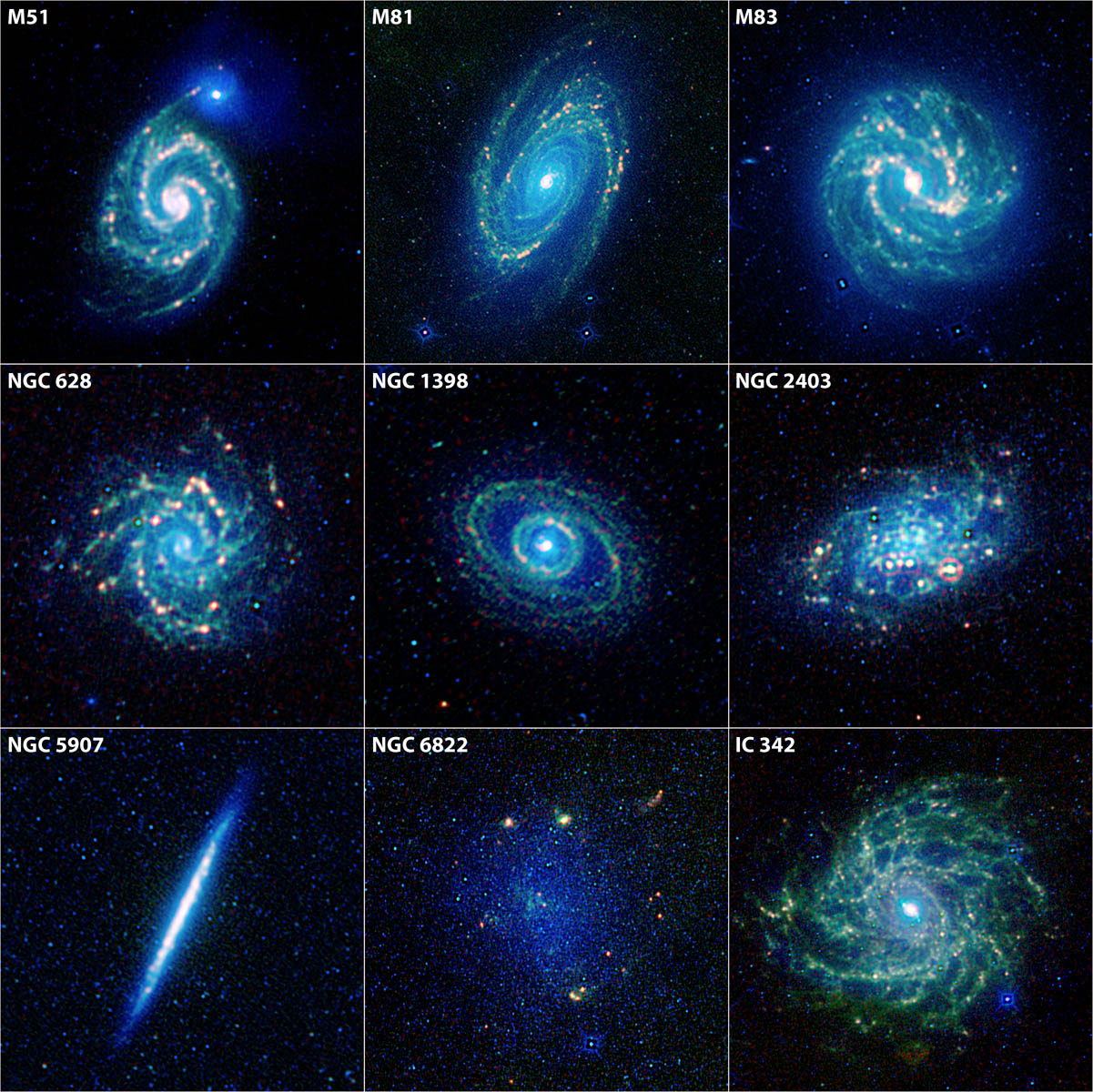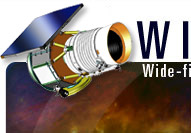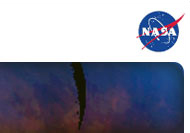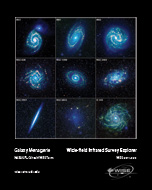| |
|
WISE
Home
 |
 |
 |
Images

Movies & Simulations

Slideshows

Podcasts

WWT Guided Tour
|
| |
|
|
 |
 |
Download Options:
Without Caption:
small (355K) 1201 x 1200 JPEG
large (2.78M) 3600 x 3600 JPEG
original (22.3M) 3600 x 3600 TIFF
With Caption:
small (361K) 1201 x 1200 JPEG
large (2.81M) 3600 x 3600 JPEG
original (22.3M) 3600 x 3600 TIFF
|
 |
 |
Download Options:
(Individual Galaxies)
Top Left (M51):
large (315K) 1780 x 1780 JPEG
original (2.67M) 1780 x 1780 TIFF
Top Center (M81):
small (361K) 1201 x 1200 JPEG
large (3.48M) 3770 x 3770 JPEG
original (28.3M) 3770 x 3770 TIFF
Top Right (M83):
large (696K) 2199 x 2199 JPEG
original (7.74M) 2199 x 2199 TIFF
Middle Left (NGC 628):
large (863K) 2042 x 2042 JPEG
original (8.64M) 2042 x 2042 TIFF
Center (NGC 1398):
large (266K) 1047 x 1047 JPEG
original (1.81M) 1047 x 1047 TIFF
Middle Right (NGC 2403):
large (769K) 2199 x 2199 JPEG
original (5.89M) 2199 x 2199 TIFF
Bottom Left (NGC 5907):
large (2.12M) 2618 x 2618 JPEG
original (14.4M) 2618 x 2618 TIFF
Bottom Center (NGC 6822):
large (1.87M) 2618 x 2618 JPEG
original (13.1M) 2618 x 2618 TIFF
Bottom Right (IC 342):
large (1.01M) 2356 x 2356 JPEG
original (7.74M) 2356 x 2356 TIFF
|
|
 |


May 25, 2011 - The Galaxy Menagerie from WISE
A new, colorful collection of galaxy specimens has been released by NASA's Wide-field Infrared Survey Explorer, or WISE, mission. It showcases galaxies of several types, from elegant grand design spirals to more patchy flocculent spirals. Some of the galaxies have roundish centers, while others have elongated central bars. The orientation of the galaxies varies as well, with some seeming to peer straight back at us in the face-on configuration while others point to the side, appearing edge-on.
Infrared light has been translated into colors we see with our eyes, such that the shortest wavelengths are blue and the longest are red. The oldest stars appear blue, while pockets of newly formed stars have yellow or reddish hues. Below is more information about each member of WISE's galaxy collection. The order is from top left to right; middle left to right; and bottom left to right.
The Whirpool Galaxy, or Messier 51 (M51)
Known by astronomers as M51, this beauty is a grand design spiral, which are galaxies with well-defined spiral arms. Its smaller companion, a dwarf galaxy called NGC 5195, is thought to have helped define and shape the arms due to its gravitational "dance" with its larger partner. M51 is also known as "The Lord Ross Galaxy," after the astronomer who was the first to study its spiral structure in the 1840s. It is located 25 million light-years away in the constellation Canes Venatici, and is 81,000 light-years across.
Bode's Galaxy, or Messier 81 (M81)
M81 is another grand design spiral galaxy, with pronounced arms spiraling into its core. WISE highlights areas where gas and dust have been compressed in the arms, leading to the formation of new stars. This compression has been enhanced by the galaxy's interaction with its partner galaxy, Messier 82 (not pictured here). That galaxy is bursting with new stars, and is therefore known as a "starburst." M81 is 12 million light-years away in the constellation Ursa Major, and 94,000 light-years across.
Southern Pinwheel Galaxy, or Messier 83 (M83)
At about 55,500 light-years across, M83 is s a bit more than half the size of our Milky Way Galaxy, but it has a similar overall structure. Like the Milky Way, most of M83's stars, dust, and gas lie in a thin disk decorated with grand spiral arms. This galaxy is classified as a barred spiral because, in addition to a central bulge of stars, it has a central bar-shaped region of stars. It is 15 million light-years away in the constellation Hydra.
NGC 628, or Messier 74 (M74)
Some astronomers call the grand design spiral Messier 74 the "perfect spiral," for its exceptional symmetry. It is suspected to have a black hole at its center, with a mass equal to 10,000 suns. It is one of only a handful of known black holes with masses intermediate between the relatively smaller ones that form from collapsing stars and the supermassive black holes millions of times more massive than the sun. Supermassive black holes are more typically found at the centers of galaxies. Messier 74 is located between 24.5 and 36 million light-years away in the constellation Pisces, and is 100,000 light-years across.
NGC 1398
This barred spiral has a dense inner ring that surrounds a bright, central core. The ring is actually two spiral arms that are closed in on each other. In contrast to its well-defined center, this galaxy's arms are patchy, or flocculent. It is inclined about 43 degrees away from an edge-on orientation, and has a diameter of 135,000 light-years. NGC 1398 is 65 million light-years away in the Fornax constellation, and is part of the Fornax cluster of galaxies.
NGC 2403
This fuzzy-looking galaxy is a flocculent, or patchy, spiral. It is largely veiled by gas and dust at visible-light wavelengths, but when viewed with WISE, its arms are clearly revealed. In 2004, NGC 2403 was host to one of the largest supernova in recent decades -- SN 2004dj was first observed in 2004 in Japan and was visible for 8 months. NGC 2403 is located 11.4 million-light years away in the constellation Camelopardalis, and is about 73,000 light-years across.
Splinter or Knife Edge Galaxy, or NGC 5907
This galaxy's face is angled about 90 degrees from our view, so it appears edge-on and thin as a splinter, or knife. It was discovered by the astronomer William Herschel in 1788. There is a large complex of stellar streams surrounding the galaxy, which can't be seen in the WISE image. These are the torn-up shreds of smaller galaxies that were consumed. The faint green hue seen in the WISE composite is due to the "halo" of old stars that encircles the central region of the galaxy. The Splinter Galaxy is about 53 million light-years away in the constellation Draco, and is nearly 200,000 light-years across.
Barnard's Galaxy, or IC 4895 or NGC 6822
Barnard's Galaxy is known as a dwarf for its small size -- it has only about one percent of the mass of the Milky Way. The galaxy's irregular shape is dominated by a central bar of stars, whose appearance resembles that of the nearby satellite galaxy, the Large Magellanic Cloud. It is therefore given a classification of "Magellanic type." The prominent yellow blobs seen against the blue stellar background are sites of recent star formation. Barnard's Galaxy is 1.6 million light-years away in the Sagittarius constellation, and is about 7,000 light-years across.
Hidden Galaxy, or IC342
Sometimes called the Hidden Galaxy, this spiral beauty is shrouded behind our own galaxy, the Milky Way. Stargazers and professional astronomers have a hard time seeing the galaxy through the Milky Way's bright band of stars, dust and gas. WISE's infrared vision cuts through this veil, offering a crisp view. The nucleus is very bright at infrared wavelengths, due to a burst of new stars forming there. The Hidden Galaxy is located about 10 million light-years away in the constellation Camelopardalis, and is 62,000 light-years across.
The colors used in all of these image represent specific wavelengths of infrared light. Blue and cyan represent 3.4- and 4.6-micron light, mainly emitted by hot stars. Green and red represent 12- and 22-micron wavelengths, primarily light emitted from warm dust.
Image Credit: NASA/JPL-Caltech/WISE Team |
|
| |
|
| -About the Objects- |
| Names: Messier 51 (M51, Whirlpool Galaxy, NGC 5194); Messier 81 (M81, NGC 3031, Bode’s Galaxy); Messier 83 (M83, Southern Pinwheel Galaxy); Messier 74 (M74, NGC 628); NGC 1398; NGC 2403; NGC 5907 (NGC 5906, Splinter Galaxy, Knife Edge Galaxy); IC 4895 (Barnard's Galaxy, NGC 6822, or Caldwell 57); IC 342 (Hidden Galaxy) |
| Types: Galaxy > Interacting (M51); Galaxy > Spiral (M81, M74, IC 342, NGC 5907, NGC 2403); Galaxy > Barred (M83, NGC 1398); Galaxy > Dwarf (IC 4895) |
Distances: 25 million light-years (M51); 12 million light-years (M81); 15 million light-years (M83); Between 24.5 and 36 million light-years (M74); 65 million light-years (NGC 1398); 11.4 million light-years (NGC 2403); 53 million light-years (NGC 5907); 1.6 million light-years (IC 4895); 10 million light-years (IC 342) |
| Sizes (Major Axis Diameter): 81,000 light-years (M51); 94,000 light-years (M81); 55,500 light-years (M83); 100,000 light-years (M74); 135,000 light-years (NGC 1398); 72,676 light-years (NGC 2403); 197,304 light-years (NGC 5907); 7,133 light-years (IC 4895); 62,000 light-years (IC 342) |
| -About the Images- |
| Position of objects (J2000): RA 13h 29m 55s; Dec +47° 13’ 54” (M51); RA 9h 55m 33s; Dec +69° 03’ 55” (M81); RA 13h 37m 00s; Dec -29° 52’ 00” (M83); RA 01h 36m 41s; Dec +15 degrees 47’ 00” (M74); RA 03h 38m 52.130s; Dec -26° 20’ 16.22” (NGC 1398); RA 07h 36m 51.396s; Dec +65° 36’ 09.17” (NGC 2403); RA 15h 15m 53.687s; Dec +56° 19’ 43.86” (NGC 5907); RA 19° 44 57.8s; Dec -14° 48’ 11” (IC 4895); RA 03h 46m 49s, Dec +68° 05’ 47” (IC 342) |
| Constellations: Canes Venatici (M51); Ursa Major (M81); Hydra (M83); Pisces (M74); Fornax (NGC 1398); Camelopardalis (NGC 2403); Draco (NGC 5907); Sagittarius (IC 4895); Camelopardalis (IC 342) |
| Fields of View: 0.34 x 0.34 degrees (M51); 0.72 x 0.72 degrees (M81); 0.42 x 0.42 degrees (M83); 0.39 x 0.39 degrees (M74); 0.20 x 0.20 degrees (NGC 1398); 0.45 x 0.45 degrees (NGC 2403); 0.50 x 0.50 degrees (NGC 5907); 0.50 x 0.50 degrees (IC 4895); 0.45 x 0.45 degrees (IC 342) |
| Orientations: North is: 35.7 degrees left of vertical (M51); Straight up (M81); straight up (M83); straight up (M74); 144.3 degrees right of vertical (NGC 1398); 166.5 degrees right of vertical (NGC 2043); straight up (NGC 5907); straight up (IC 4895); 199.5 degrees right of vertical (IC 342) |
| Color Mapping: Blue=3.4 microns; Cyan=4.6 microns; Green=12 microns; Red=22 microns |
|
|





